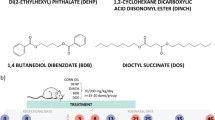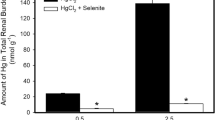Abstract
The embryotoxic and teratogenic effects of methylmercury in experimental animals have been established by several investigators. The protective activity of 2,3-dimercaptopropanol (BAL) and sodium 2,3-dimercaptopropane-1-sulfonate (DMPS, a chelator used in the treatment of inorganic and organic mercury) on methylmercury chloride (MMC)-induced maternal and developmental toxicity in mice has been evaluated in the present study. BAL and DMPS were administered subcutaneously or by gavage to pregnant mice immediately after a single oral administration of 30 mg MMC/kg given on day 10 of gestation and at 24, 48, and 72 h thereafter. Amelioration by BAL and DMPS of MMC embryo/fetotoxicity was assessed at 15, 30, and 60 mg/kg/day and at 90, 180, and 350 mg/kg/day, respectively. Treatment with BAL did not ameliorate the maternal toxicity or the developmental toxicity of MMC observed in the mouse. In contrast, DMPS at 90, 180, and 360 mg/kg/day significantly reduced the maternal lethality of MMC, whereas treatment with 180 and 360 mg DMPS/kg/day showed significant protective activity against MMC-induced embryotoxicity and teratogenicity. Based on the present findings, DMPS might be a useful chelator against the maternal and developmental toxicity induced by methylmercury.
Similar content being viewed by others
References
Aposhian HV (1983) DMSA and DMPS- water soluble antidotes for heavy metal poisoning. Annu Rev Pharmacol Toxicol 23:193–215
Aposhian HV, Aposhian MM (1990) Meso-2,3-dimercaptosuccinic acid: chemical, pharmacological and toxicological properties of an orally effective metal chelating agent. Annu Rev Pharmacol Toxicol 30:279–306
Aposhian HV, Maiorino RM, Rivera M, Bruce DC, Dart RC, Hurlbut KM, Levine DJ, Zheng W, Fernando Q, Carter D, Aposhian MM (1992) Human studies with the chelating agents DMPS and DMSA. Clin Toxicol 30:505–528
Ballatori N, Clarkson TW (1984) Inorganic mercury secretion into bile as a low molecular weight complex. Biochem Pharmacol 33: 1087–1092
Bosque MA, Domingo JL, Paternain JL, Llobet JM, Corbella J (1990) Evaluation of the developmental toxicity of 2,3-dimercaptopropane-1-sulfonate (DMPS) in mice. Effect on mineral metabolism. Toxicology 62:311–320
Bosque MA, Domingo JL, Llobet JM, Corbella J (1991) Effects of meso-2,3-dimercaptosuccinic acid (DMSA) on the teratogenicity of sodium arsenate in mice. Bull Environ Contam Toxicol 47:682–688
Buchet JP, Lauwerys RR (1989) Influence of 2,3-dimercaptopropane-1-sulfonate and dimercaptosuccinic acid on the mobilization of mercury from tissues of rats pretreated with mercury chloride, phenylmercury acetate or mercury vapors. Toxicology 54:323–333
Clarkson TW, Magos L, Cox C, Greenwood MR, Amin-Zaki L, Majeed MA, Al-Damluji SF (1981) Tests of efficacy of antidotes for removal of methylmercury in human poisoning during the Iraq outbreak. J Pharmacol Exp Ther 218:74–83
Dawson AB (1926) A note on the staining of the skeleton of cleared specimen with Alizarin red S. Stain Technol 1:123–124
Domingo JL, Bosque MA, Piera V (1991) Meso-2,3-dimercaptosuccinic acid and prevention of arsenite embryotoxicity and teratogenicity in the mouse. Fundam Appl Toxicol 17:314–320
Domingo JL, Bosque MA, Llobet JM, Corbella J (1992) Amelioration by BAL (2,3-dimercapto-1-propanol) and DMPS (sodium 2,3-dimercaptopropane-1-sulfonic acid) of arsenite developmental toxicity in mice. Ecotoxicol Environ Safety 23:274–281
Endo A, Watanabe T (1988) Analysis of protective activity of N-acetylcysteine against teratogenicity of heavy metals. Reprod Toxicol 2:141–144
Fujimoto T, Fuyuta M, Kiyofuji E, Hirata S (1979) Prevention by tiopronin (2-mercaptopropionyl glycine) of methylmercuric chloride-induced teratogenic and fetotoxic effects in mice. Teratology 20:297–302
Fuyuta M, Fujimoto T, Hirata S (1978) Embryotoxic effects of methylmercuric chloride administered to mice and rats during organogenesis. Teratology 18:353–366
Harris SB, Wilson JG, Printz RH (1972) Embryotoxicity of methyl mercuric chloride in golden hamsters. Teratology 6:139–142
Hojberg S, Nielsen JB, Andersen O (1992) Effects of dietary lipids on whole-body retention and organ distribution of organic and inorganic mercury in mice. Food Chem Toxic 30:703–708
Hood RD, Pike CT (1972) BAL alleviation of arsenate-induced teratogenesis in mice. Teratology 6:235–238
Hood RD, Vedel GC (1984) Evaluation of the effect of BAL (2,3-dimercaptopropanol) on arsenite-induced teratogenesis in mice. Toxicol Appl Pharmacol 73:1–7
Hoskins BB, Hupp EW (1978) Methylmercury effects in rat, hamster and squirrel monkey. Environ Res 15:5–19
Khera KS (1973) Teratogenic effects of methyl mercury in the cat: Note on the use of this species as a model for teratogenicity studies. Teratology 8:293–304
Klaassen CD (1990) Heavy metals and heavy-metal antagonists. In: Gilman AG, Rall TW, Nies AS, Taylor P (eds) The pharmacological basis of therapeutics. Pergamon Press, NY, pp 1592–1614
Kudo A, Miyahara S (1984) Mercury dispersion from Minamata bay to the Yatsuhiro sea during 1975–1980. Ecotoxicol Environ Safety 8:507–510
—, — (1988) Effect of decontamination project at Minamata bay. Ecotoxicol Environ Safety 15:339–343
Léonard A, Jacquet P, Lauwerys RR (1983) Mutagenicity and teratogenicity of mercury compounds. Mutat Res 114:1–18
Nielsen JB, Andersen O (1991) Effect of four thiol-containing chelators on disposition of orally administered mercuric chloride. Hum Exp Toxicol 10:423–430
Nishimura H, Takagaki S (1959) Developmental anomalies in mice induced by 2,3-dimercaptopropanol (BAL). Anat Rec 136:261–267
Olson BH, Cayless SM, Ford S, Lester JN (1991) Toxic element contamination and the occurrence of mercury-resistant bacteria in Hg-contaminated soil, sediments, and sludges. Arch Environ Contam Toxicol 20:226–233
Sanchez DJ, Gomez M, Llobet JM, Domingo JL (1993) Effects of meso-2,3-dimercaptosuccinic acid (DMSA) on methyl mercury-induced teratogenesis in mice. Ecotoxicol Environ Safety (in press)
Wilson JG (1965) Embryological considerations in teratology. In: Wilson JG, Warkany J (eds) Teratology: Principles and techniques. University of Chicago Press, Chicago, IL, pp 251–277
Zalups RK, Gelein RM, Cernichiari E (1991) DMPS as a rescue agent for the nephropathy induced by mercuric chloride. J Pharmacol Exp Ther 256:1–10
Zander D, Ewers U, Freier I, Brockhaus A (1992) Studies on human exposure to mercury. III. DMPS induced mobilization of mercury in subjects with and without amalgam fillings (in German). Zbl Hyg 192:447–454
Author information
Authors and Affiliations
Rights and permissions
About this article
Cite this article
Gomez, M., Sanchez, D.J., Colomina, M.T. et al. Evaluation of the protective activity of 2,3-dimercaptopropanol and sodium 2,3-dimercaptopropane-1-sulfonate on methylmercury-induced developmental toxicity in mice. Arch. Environ. Contam. Toxicol. 26, 64–68 (1994). https://doi.org/10.1007/BF00212795
Received:
Revised:
Issue Date:
DOI: https://doi.org/10.1007/BF00212795




